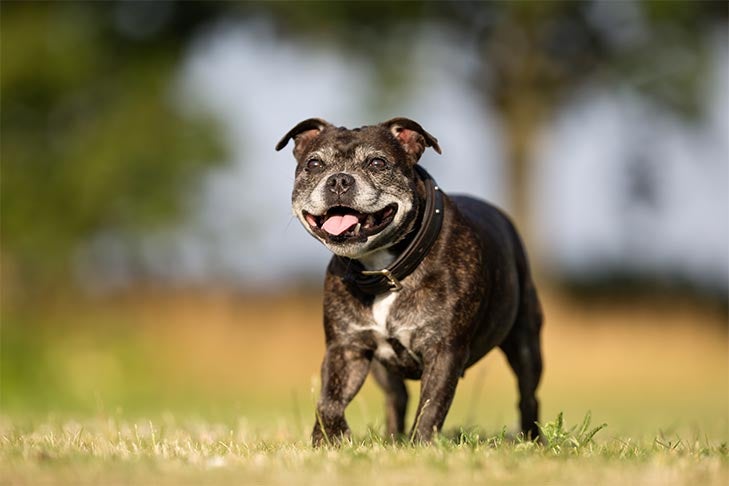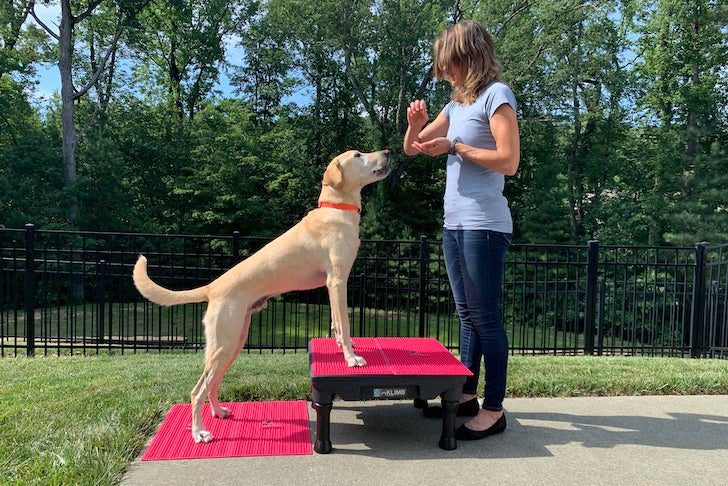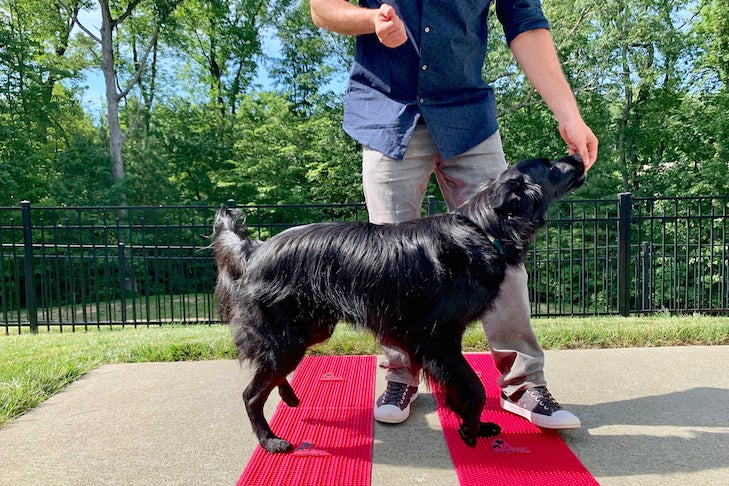- Aging dogs can lose rear limb strength and the ability to know exactly where their feet are.
- Age-appropriate exercises can benefit a senior dog's quality of life.
- Strength- and flexibility-building exercises can be practiced in the comfort of home.

“Use it, or lose it,” so the saying goes, and this applies to dogs as well as people. That’s why regular exercise becomes more important with each passing year, and especially impactful for senior dogs.
“Many older dogs often lose strength in their rear limbs, as well as proprioception—essentially the ability to know where their feet are,” says Dr. Barbara Butler, DVM, Certified Canine Rehabilitation Therapist (CCRT) and certified veterinary acupuncturist. “It’s important for owners to do some exercises at home that are age- and skill-appropriate for their dog. Doing so can have a large impact on a senior dog’s quality of life physically and in terms of mental sharpness.”
Swimming, leash walks, and gentle games of fetch are all wonderful ways to maintain fitness. But there are also many strength and flexibility moves—canine calisthenics—that can be performed in the comfort of your home. The three easy exercises presented here will work problem areas for many seniors.
Your first step is to talk to your veterinarian to make sure your exercise plan is appropriate for your dog’s current fitness level. Then, grab your treats and your beloved oldster and get started. You can do these exercises every other day. Strive for one to three sets of two to five repetitions of each exercise. This may take some training and conditioning over time. Warmup and cool down with a five-minute leash walk before and after.
Power Posing
What it is: Performing basic obedience moves on various surfaces.
Benefits: Tones the abdominal wall, spine, shoulders, and hips.
What you need: Start with a non-slippery floor, or something flat with a nubby surface, such as a yoga mat, foam dog bed, or mattress. Start on the floor and progress to more challenging surfaces.
How to do it: Start with your dog standing with all four paws on whatever surface you choose. Have your dog progress through these positions—sit, down, sit, down, stand, down, stand—for one repetition. If your dog does not know those behaviors on cue, use a treat to lure him into these positions.
Building Up The Rear

What it is: Placing front legs on an elevated platform and stretching neck up slightly.
Benefits: Your dog naturally frontloads 60 to 70 percent of their weight onto their forelimbs. This task shifts weight onto the rear limbs and firms them up.
What you need: This exercise requires a platform—a duct-taped textbook, non-slick step stool, step on a porch or deck, aerobic bench, or square table made for dog training, such as a KLIMB.
How to do it: Using a piece of kibble under their nose, lure your dog to walk into a standing position with their front feet on the platform. Stand in front of your dog and slowly feed them about 10 pieces of kibble over 10 seconds. That’s one repetition. Their shoulders should be directly over their wrists as they look slightly up at the incoming food. Work up to 30 seconds for one repetition.
If your dog eagerly leans forward to obtain the treats and shifts their shoulders over their wrists towards you, you will accidentally bolster up forelimbs instead of hindlimbs. If your dog gives you a stand with an arched back like an angry Halloween cat, walk your dog off the platform and reset them with a more normal standing pose.
Lateral Walking

What it is: Stepping sideways in a step-together-step dance move.
Benefits: Lateral walking engages the supporting muscles of the hips and shoulders in a sideways motion, called adduction and abduction. This helps prevent shoulder and knee injuries. By fortifying those stabilizing muscles, your dog will be better able to change direction while romping through the yard, regain his balance after a misstep, and get on and off furniture safely.
What you need: Find an area, such as a hallway or living room, with space. You may use a textured, or nubby, surface—two yoga mats set side by side the long way or two rows of Flexiness SensiMats—for your dog’s feet so your dog can see and feel a “target.” The bumps on the mat’s nubby surface will also stimulate your dog’s sense of touch and strengthen their toes and feet.
How to do it: Your dog will walk sideways. To laterally step left, start with your dog on the left as if you are both looking in a mirror. You should be in the heel position with your dog’s right shoulder next to your left knee. Take treats in your right hand and turn your body 90 degrees so that if you took a step, you’d be walking into your dog’s shoulder. Put the treats in front of your dog’s nose with your right hand. Take a two-inch step with each of your legs toward your dog without physically touching your dog. Your personal space or “force field bubble” will knock into your dog’s “force field bubble.”
Most dogs will take a lateral step to the left to alleviate the spatial pressure. The moment they take a step, praise them and give a treat. Continue to put the spatial pressure on your dog and treat when they take a side step. After going a few feet, switch sides and laterally walk back to where you started. This completes one repetition.
Jasey Day, a Certified Canine Fitness Trainer and a member of the Bobbie Lyons K9FITteam, has been teaching dog training classes for over 15 years. Her dogs have titled in dock diving, Agility, trick dog, and Rally. Cannon and Turbo, her Labrador Retrievers, enthusiastically assist her in her classes.
This column first appeared in the September/October 2019 issue of AKC Family Dog magazine.
The AKC is here to help owners with questions and concerns about COVID-19 and dogs. Find answers to your questions, plus at-home activity ideas, training tips, educational resources, and more on our Coping With COVID-19 hub.
This article is intended solely as general guidance, and does not constitute health or other professional advice. Individual situations and applicable laws vary by jurisdiction, and you are encouraged to obtain appropriate advice from qualified professionals in the applicable jurisdictions. We make no representations or warranties concerning any course of action taken by any person following or otherwise using the information offered or provided in this article, including any such information associated with and provided in connection with third-party products, and we will not be liable for any direct, indirect, consequential, special, exemplary or other damages that may result, including but not limited to economic loss, injury, illness or death.






